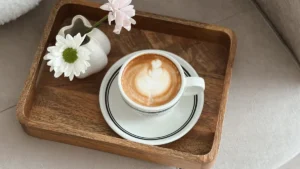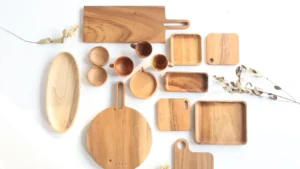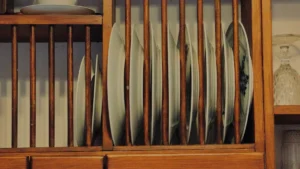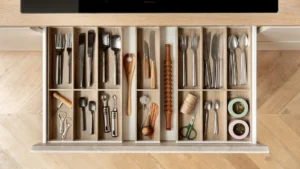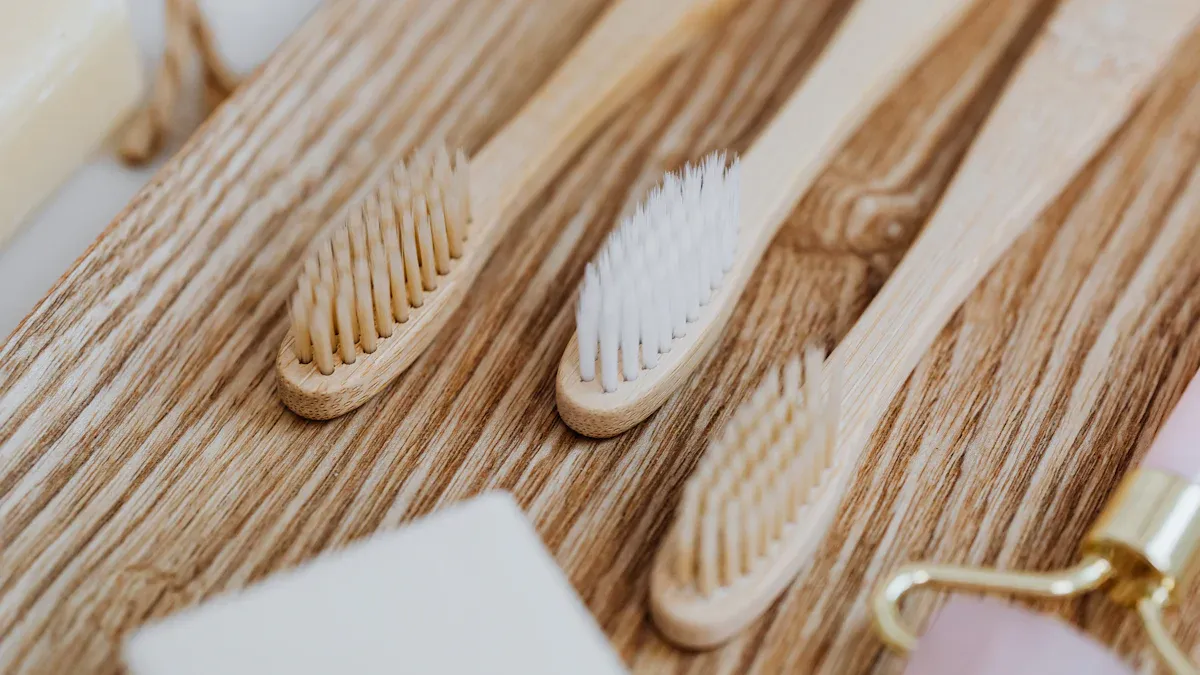
Are you looking for a way to make your home greener? Bamboo lap trays give you an eco-friendly option that helps protect the planet. These trays come from fast-growing bamboo, a renewable plant that breaks down naturally. You can lower your carbon footprint and reduce waste with this simple switch.
Choosing [“bamboo lap trays“] supports sustainable living and keeps harmful plastic out of landfills.
Eco-Friendly Benefits of Bamboo Lap Trays
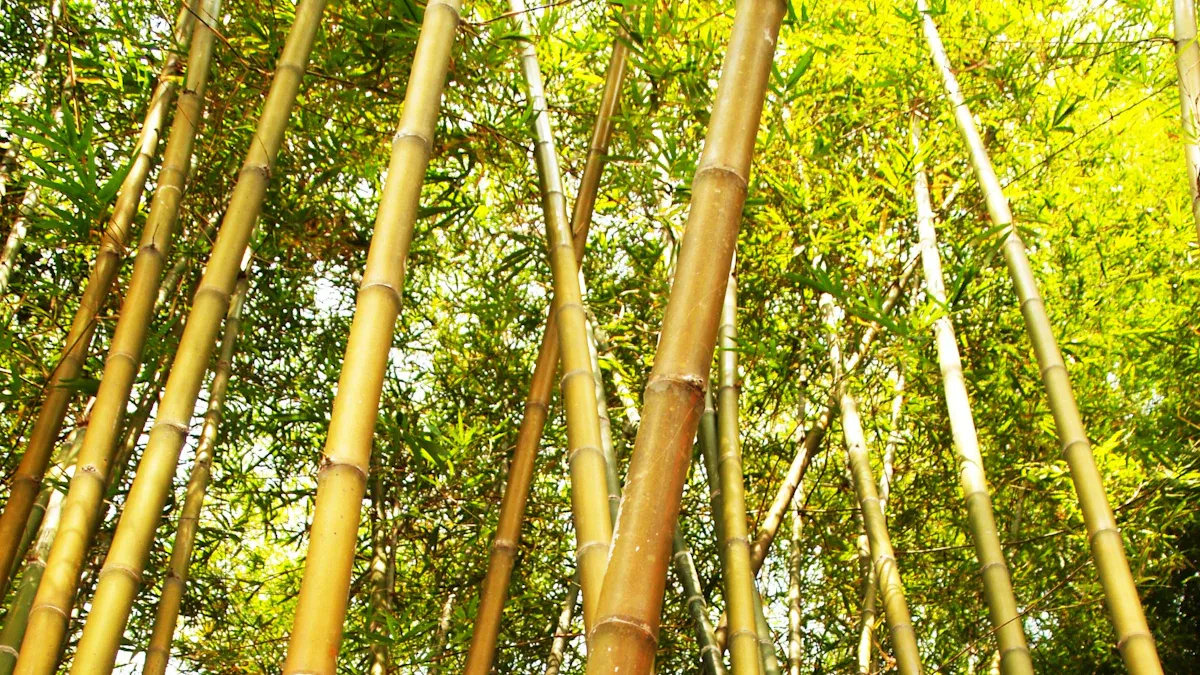
Renewable Resource Advantage
When you choose bamboo lap trays, you pick a product made from one of the world’s most renewable resources. Bamboo grows much faster than trees. In fact, some types of bamboo can grow up to 3 feet in a single day! Most bamboo reaches full size in just 3 to 5 years, while trees used for wood products can take decades to mature. This quick growth means farmers can harvest bamboo more often without hurting the environment.
Here’s a quick comparison:
| Resource | Renewability | Environmental Impact |
|---|---|---|
| Bamboo | Rapid growth, regenerates without replanting | Sustainable, biodegradable, absorbs CO2 |
| Plastic | Non-renewable, takes hundreds of years to decompose | Contributes to pollution and climate change |
Bamboo also keeps growing after you cut it. The roots stay in the ground and send up new shoots, so there’s no need to replant. This makes bamboo a smart choice for anyone who wants to support a healthy planet.
Fast-Growing and Sustainable
Bamboo is famous for its speed. It can reach maturity in just a few years, which is much faster than most trees. Farmers can harvest bamboo every 3 to 5 years, and it keeps coming back. This steady supply helps protect forests and gives farmers a reliable income.
- Bamboo can grow as fast as 3 feet per day.
- It matures in 3 to 5 years, while trees take decades.
- Bamboo plantations absorb up to 12 tons of carbon dioxide per hectare each year.
- They also produce 35% more oxygen than the same area of trees.
Bamboo farming is also good for the land. It grows well in poor soil and does not need much help from fertilizers or pesticides. This makes bamboo lap trays a sustainable and responsible choice for your home.
Tip: By picking products made from bamboo, you help reduce the need for plastic and protect natural forests.
Minimal Land and Water Use
Bamboo uses less land and water than many other crops. It grows close together, so farmers can plant more in a smaller space. Bamboo also needs less water than trees, which helps save this precious resource.
Here’s how bamboo compares to other materials:
| Material | Average Growth Rate |
|---|---|
| Bamboo | Maturity in 3 to 5 years |
| Trees | Maturity in decades |
Bamboo lap trays are compostable and break down naturally in just a few months. Plastic trays, on the other hand, can take hundreds of years to decompose and often end up polluting the environment. Bamboo is grown without harmful chemicals, so it is safer for the soil and water around the farms.
When you bring bamboo lap trays into your home, you make an eco-friendly choice that helps save water, land, and energy. You also help keep plastic waste out of landfills and oceans.
Biodegradability and Compostability of Bamboo Lap Trays
Natural Breakdown Process
You might wonder what happens to bamboo lap trays after you finish using them. Bamboo breaks down much faster than plastic. In the right conditions, bamboo utensils can decompose in just 6 to 12 months. Plastic trays, on the other hand, can stick around for hundreds of years and often turn into harmful microplastics. When bamboo sits in soil, fungi and insects help it break down. Water and heat speed up this process. Microorganisms create tiny holes in the bamboo, letting in more air and moisture. This helps bamboo turn into natural elements like carbon dioxide, water, and minerals. These elements go back into the earth and help new plants grow.
- Bamboo decomposes into natural elements that enrich the soil.
- Plastic takes centuries to break down and can harm the environment.
Reducing Landfill Waste
Switching to bamboo lap trays helps you cut down on landfill waste. When you throw away plastic trays, they pile up in landfills and stay there for generations. Bamboo, however, breaks down quickly and does not leave behind toxic chemicals. In landfill conditions, bamboo can decompose in as little as 6 months to 3 years. This means less trash and a cleaner planet for everyone.
Here’s a quick look at how long different materials take to break down:
| Material | Time to Decompose |
|---|---|
| Bamboo | 6-12 months |
| Plastic | Hundreds of years |
Composting at Home
You can compost bamboo lap trays at home just like you would with other organic materials. To get the best results, break the trays into smaller pieces before adding them to your compost pile. Mix them with food scraps, leaves, and other compostable items. This helps the bamboo break down faster and adds valuable nutrients to your compost. Bamboo contains both nitrogen and carbon, which improve the quality of your compost. Many cities also accept compostable bamboo plates and trays in their municipal compost programs. If you want to make your own rich soil at home, bamboo is a great choice.
Tip: Always mix bamboo with other compost ingredients and keep your compost pile moist for the fastest results.
Bamboo Lap Trays vs. Plastic: Chemical and Microplastic Pollution
No Harmful Additives
When you use bamboo lap trays, you avoid many of the chemicals found in plastic products. Some plastic trays contain additives that can leach into your food or drinks, especially when heated. Researchers have found that both bamboo and plastic dishware may use melamine as a binder. Melamine can move into your food, and even small amounts may affect your health. Studies link melamine exposure to problems with brain development and reproductive health. Unlike many plastics, bamboo trays do not need extra chemicals to stay strong or flexible. You get a safer product for your family.
- Bamboo dishware sometimes uses melamine as a binder.
- Melamine can leach into food and may cause health issues.
- Plastic trays may contain other harmful additives, but research comparing the two is limited.
Microplastics in Plastic Trays
Plastic trays can break down over time, releasing tiny pieces called microplastics. These microplastics can end up in your home’s air and dust. You might not see them, but they are there. Everyday items like toys, cables, and even kitchen utensils add to this problem. When you use plastic trays, especially with hot food, you increase the chance of microplastics getting into your meals and your home.
Here’s a table showing where microplastics come from and how they affect your household:
| Source of Microplastics | Impact on Household Environment |
|---|---|
| Toys | Wear and degradation releasing MPs into dust |
| Cables and Insulation | Accumulation of MPs in air due to degradation |
| Ventilation Systems | Redistribution of MPs in indoor air |
| Cleaning Products | Contribution of MPs from personal care items |
| Synthetic Clothing | Release of microfibers into air and water |
| Furniture and Decor | Gradual release of MPs from synthetic materials |
| Kitchen Utensils | Heating and wear of plastics releasing MPs |
You can see that plastic trays are just one part of a bigger problem. Microplastics can move around your home and even get into your food and water.
Healthier Home Environment
You want a clean and safe home for your family. Choosing bamboo lap trays helps you avoid many of the risks linked to plastic. Bamboo does not release microplastics when you use it. You also skip the harmful additives that can come with plastic trays. Your air stays cleaner, and your food stays safer. When you pick bamboo, you make a simple change that supports a healthier home and a cleaner planet.
Lower Carbon Footprint with Bamboo Lap Trays
Energy-Efficient Production
You might not realize how much energy goes into making everyday products. When you choose bamboo lap trays, you pick a product that uses less energy from start to finish. Bamboo grows quickly and does not need heavy machinery for planting or harvesting. Workers can often cut bamboo by hand. Factories that make bamboo trays use less electricity because bamboo is easy to shape and process. Plastic, on the other hand, comes from oil. Companies must drill, transport, and refine oil before turning it into plastic. This process uses a lot of energy and creates more pollution. By picking bamboo, you help cut down on greenhouse gas emissions.
Bamboo as a Carbon Sink
Bamboo does more than just grow fast. It also acts as a carbon sink. This means bamboo pulls carbon dioxide out of the air and stores it in its stalks and roots. One acre of bamboo can absorb up to 12 tons of carbon dioxide each year. That is more than many types of trees. When you use bamboo products, you support plants that help clean the air. Bamboo also releases more oxygen than trees of the same size. You get a tray that looks good and helps the planet breathe easier.
Did you know? Bamboo can produce 35% more oxygen than an equal stand of trees!
Greener Disposal Methods
When your bamboo lap tray reaches the end of its life, you have several earth-friendly ways to dispose of it:
- Composting: Break your tray into small pieces and add it to your compost pile. Microbes will turn it into rich soil for your garden.
- Bioconversion: Some facilities use bamboo waste to make biogas and biofertilizers. This process creates renewable energy and helps farms grow healthy crops.
- Recycling into new products: Factories can turn old bamboo trays into paper, textiles, or even new composite materials.
Plastic trays usually end up in landfills or the ocean, where they stay for hundreds of years. Bamboo trays break down naturally and can even help new plants grow. By choosing bamboo, you make a smart choice for a cleaner, greener world.
Practical Eco-Friendly Benefits for Households
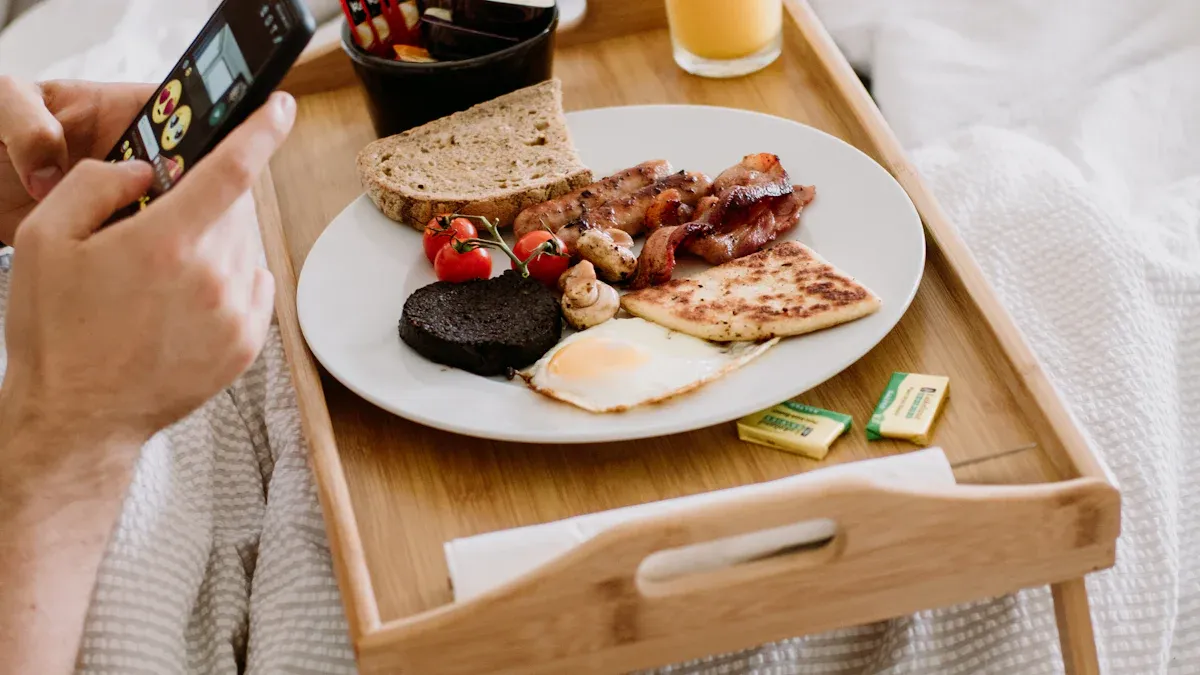
Durable and Long-Lasting
You want a lap tray that stands up to daily use. Bamboo lap trays deliver on durability. Their thick, sturdy construction gives them strength and helps them last for years. You can drop a bamboo tray or use it with hot food, and it will keep its shape. Plastic trays, on the other hand, often break or become warped after just a little rough handling or exposure to heat. You will notice that bamboo organizers stay neat and intact, while plastic ones may crack or look worn out over time.
- Bamboo trays are generally more durable and long-lasting compared to plastic trays.
- Bamboo organizers remain intact and appear neat for years, while plastic may crack over time.
- Bamboo is much more durable than plastic trays, which can warp over time.
When you choose bamboo, you invest in a product that keeps working for you, meal after meal.
Lightweight and Easy to Use
Bamboo lap trays feel light in your hands, but they do not sacrifice strength. You can easily carry them from room to room, and even kids can handle them without trouble. Bamboo’s natural anti-bacterial properties add another layer of safety, making it a smart choice for serving food.
| Material | Weight | Ease of Use |
|---|---|---|
| Bamboo | Lightweight yet strong | User-friendly, eco-friendly |
| Plastic | Generally lighter but less sturdy | Easier to clean, less durable |
You get a tray that is both easy to use and safe for your family.
Stylish, Versatile, and Easy to Maintain
Bamboo lap trays look beautiful in any setting. Their natural finish and elegant design add a touch of style to your home. You can use them for breakfast in bed, as a laptop desk, or even as a serving tray for guests. Bamboo trays do not release harmful chemicals, so you can serve food with confidence. Cleaning is simple—just wipe them down, and they are ready to go. If you want, you can even personalize your bamboo tray for a unique touch.
- Eco-friendly and biodegradable
- Durable and strong for daily use
- Elegant and natural look
- Safe for serving food
- Versatile for many uses
- Easy to clean and maintain
- Customizable designs
Tip: A bamboo lap tray is more than just a tray—it’s a stylish, practical, and eco-friendly upgrade for your home!
You can make a real difference by choosing bamboo lap trays. These trays come from renewable bamboo, break down naturally, and help keep plastic out of landfills. When you switch to bamboo, you:
- Cut down on pollution and waste
- Lower your home’s carbon footprint
- Support a cleaner, greener planet
Every small choice adds up. Pick bamboo lap trays and take a simple step toward sustainable living!
FAQ
Are bamboo lap trays really better for the environment than plastic trays?
Yes! Bamboo grows back quickly and needs little water. You can compost bamboo trays at home. Plastic trays take hundreds of years to break down and often end up in landfills. Choosing bamboo helps you cut down on waste and pollution.
How long do bamboo lap trays usually last?
Bamboo lap trays are strong and durable. You can use them for years with normal care. They resist cracking and warping better than most plastic trays. If you keep them dry and clean, they stay in great shape.
Can I clean bamboo lap trays in the dishwasher?
You should wash bamboo trays by hand. Use warm water and mild soap. Dishwashers use high heat and lots of water, which can damage bamboo. Wipe the tray dry after washing to keep it looking good.
Are bamboo lap trays safe for serving food?
Absolutely! Bamboo is a natural material. It does not release harmful chemicals or microplastics. You can serve hot or cold food on bamboo trays with confidence. Just make sure to clean them after each use.
What can I do with my bamboo lap tray when it wears out?
You have eco-friendly options!
- Break it into small pieces and add it to your compost pile.
- Use it as garden mulch.
- Some recycling centers accept bamboo products.
This way, you help reduce landfill waste.

